Comprehensive Analysis of Strategy Development Models for Businesses
VerifiedAdded on 2022/10/06
|9
|1986
|6
Report
AI Summary
This report delves into the crucial realm of strategy development models, providing a comprehensive analysis of tools used by businesses to achieve their objectives and navigate the complexities of the market. It begins with an introduction that highlights the importance of strategic planning in today's competitive environment, emphasizing how organizations leverage various models to gain a competitive edge. The report then explores several key models in detail. The PESTEL model is presented as a tool for evaluating macro-environmental factors, including political, economic, socio-cultural, technological, environmental, and legal aspects. Porter's Five Forces model is examined to assess the competitive dynamics within an industry. Furthermore, the Ansoff Matrix is discussed as a framework for analyzing growth and expansion strategies, including market penetration, product development, market development, and diversification. The report includes real-world examples to illustrate the practical application of these models, followed by a conclusion that underscores the significance of these models in enhancing business performance and productivity. The report also provides a list of references used in the analysis.
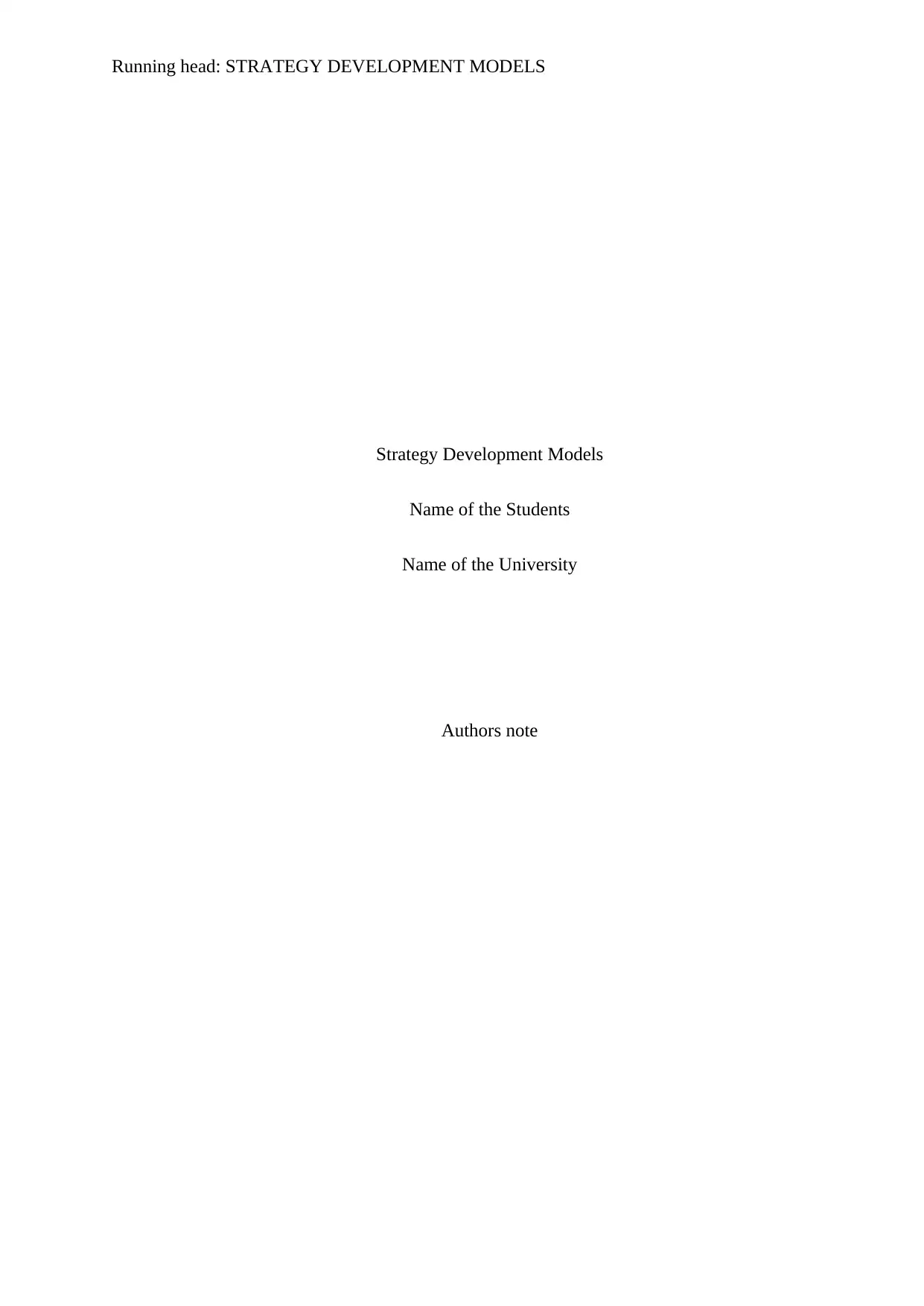
Running head: STRATEGY DEVELOPMENT MODELS
Strategy Development Models
Name of the Students
Name of the University
Authors note
Strategy Development Models
Name of the Students
Name of the University
Authors note
Paraphrase This Document
Need a fresh take? Get an instant paraphrase of this document with our AI Paraphraser
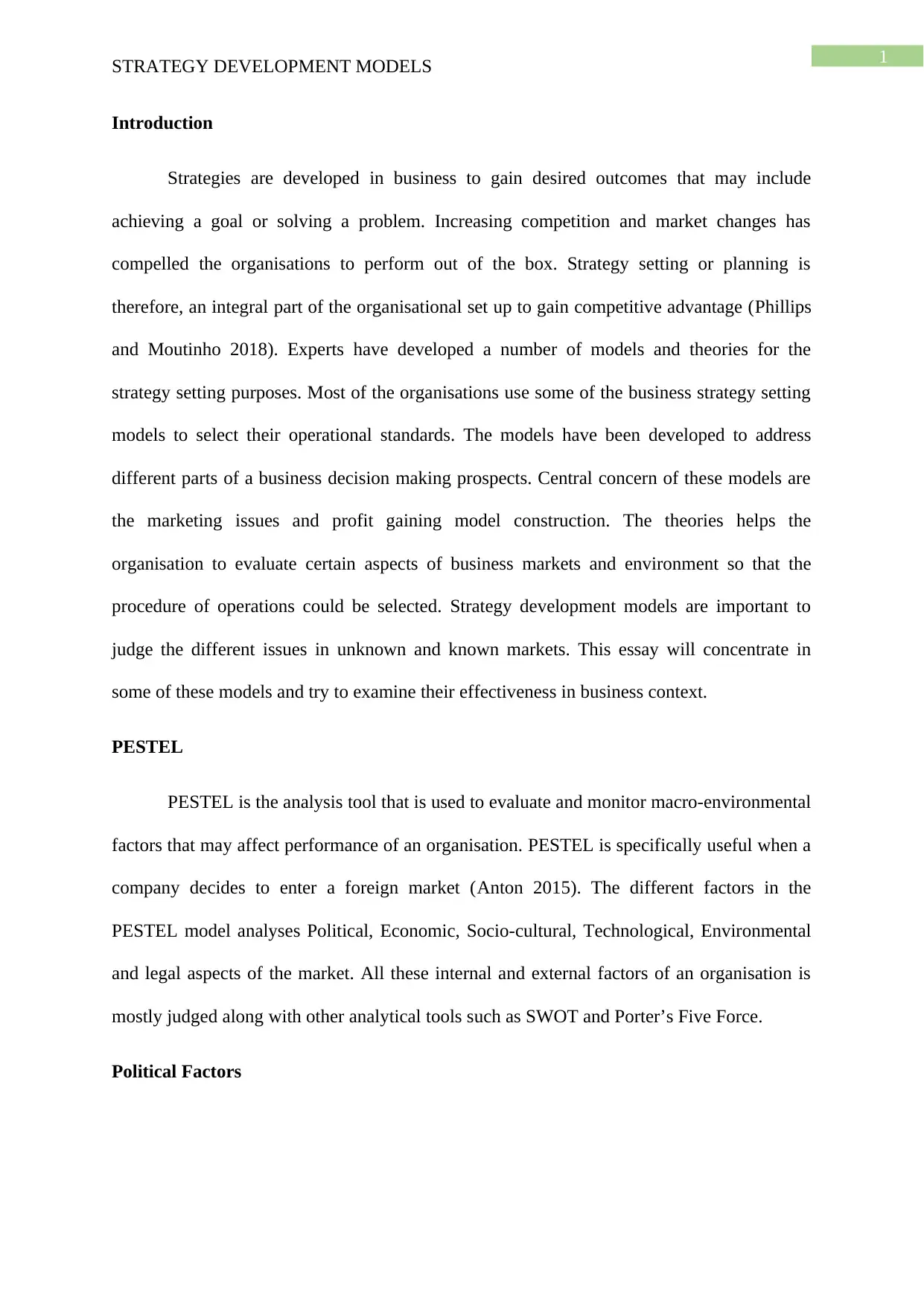
1
STRATEGY DEVELOPMENT MODELS
Introduction
Strategies are developed in business to gain desired outcomes that may include
achieving a goal or solving a problem. Increasing competition and market changes has
compelled the organisations to perform out of the box. Strategy setting or planning is
therefore, an integral part of the organisational set up to gain competitive advantage (Phillips
and Moutinho 2018). Experts have developed a number of models and theories for the
strategy setting purposes. Most of the organisations use some of the business strategy setting
models to select their operational standards. The models have been developed to address
different parts of a business decision making prospects. Central concern of these models are
the marketing issues and profit gaining model construction. The theories helps the
organisation to evaluate certain aspects of business markets and environment so that the
procedure of operations could be selected. Strategy development models are important to
judge the different issues in unknown and known markets. This essay will concentrate in
some of these models and try to examine their effectiveness in business context.
PESTEL
PESTEL is the analysis tool that is used to evaluate and monitor macro-environmental
factors that may affect performance of an organisation. PESTEL is specifically useful when a
company decides to enter a foreign market (Anton 2015). The different factors in the
PESTEL model analyses Political, Economic, Socio-cultural, Technological, Environmental
and legal aspects of the market. All these internal and external factors of an organisation is
mostly judged along with other analytical tools such as SWOT and Porter’s Five Force.
Political Factors
STRATEGY DEVELOPMENT MODELS
Introduction
Strategies are developed in business to gain desired outcomes that may include
achieving a goal or solving a problem. Increasing competition and market changes has
compelled the organisations to perform out of the box. Strategy setting or planning is
therefore, an integral part of the organisational set up to gain competitive advantage (Phillips
and Moutinho 2018). Experts have developed a number of models and theories for the
strategy setting purposes. Most of the organisations use some of the business strategy setting
models to select their operational standards. The models have been developed to address
different parts of a business decision making prospects. Central concern of these models are
the marketing issues and profit gaining model construction. The theories helps the
organisation to evaluate certain aspects of business markets and environment so that the
procedure of operations could be selected. Strategy development models are important to
judge the different issues in unknown and known markets. This essay will concentrate in
some of these models and try to examine their effectiveness in business context.
PESTEL
PESTEL is the analysis tool that is used to evaluate and monitor macro-environmental
factors that may affect performance of an organisation. PESTEL is specifically useful when a
company decides to enter a foreign market (Anton 2015). The different factors in the
PESTEL model analyses Political, Economic, Socio-cultural, Technological, Environmental
and legal aspects of the market. All these internal and external factors of an organisation is
mostly judged along with other analytical tools such as SWOT and Porter’s Five Force.
Political Factors
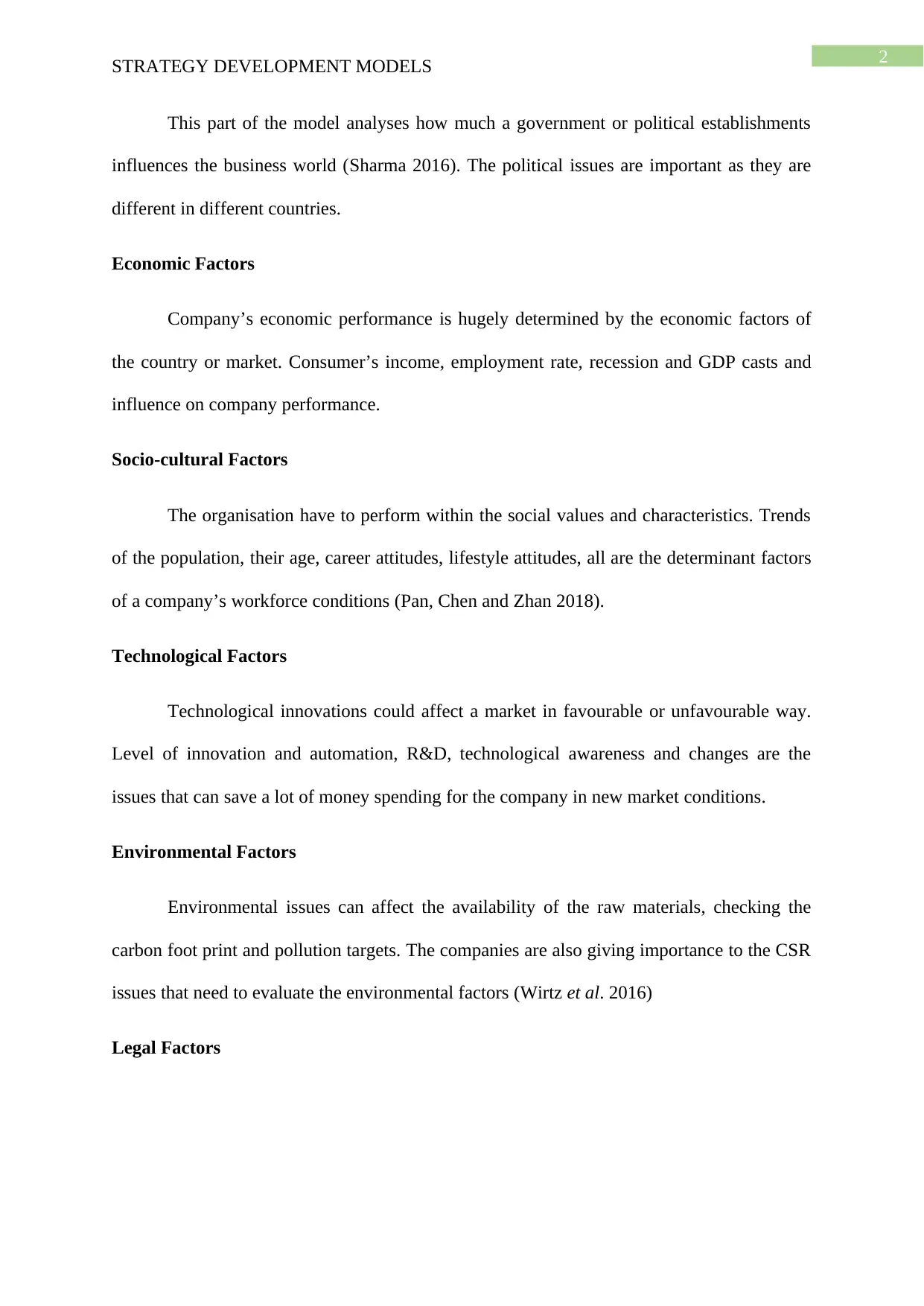
2
STRATEGY DEVELOPMENT MODELS
This part of the model analyses how much a government or political establishments
influences the business world (Sharma 2016). The political issues are important as they are
different in different countries.
Economic Factors
Company’s economic performance is hugely determined by the economic factors of
the country or market. Consumer’s income, employment rate, recession and GDP casts and
influence on company performance.
Socio-cultural Factors
The organisation have to perform within the social values and characteristics. Trends
of the population, their age, career attitudes, lifestyle attitudes, all are the determinant factors
of a company’s workforce conditions (Pan, Chen and Zhan 2018).
Technological Factors
Technological innovations could affect a market in favourable or unfavourable way.
Level of innovation and automation, R&D, technological awareness and changes are the
issues that can save a lot of money spending for the company in new market conditions.
Environmental Factors
Environmental issues can affect the availability of the raw materials, checking the
carbon foot print and pollution targets. The companies are also giving importance to the CSR
issues that need to evaluate the environmental factors (Wirtz et al. 2016)
Legal Factors
STRATEGY DEVELOPMENT MODELS
This part of the model analyses how much a government or political establishments
influences the business world (Sharma 2016). The political issues are important as they are
different in different countries.
Economic Factors
Company’s economic performance is hugely determined by the economic factors of
the country or market. Consumer’s income, employment rate, recession and GDP casts and
influence on company performance.
Socio-cultural Factors
The organisation have to perform within the social values and characteristics. Trends
of the population, their age, career attitudes, lifestyle attitudes, all are the determinant factors
of a company’s workforce conditions (Pan, Chen and Zhan 2018).
Technological Factors
Technological innovations could affect a market in favourable or unfavourable way.
Level of innovation and automation, R&D, technological awareness and changes are the
issues that can save a lot of money spending for the company in new market conditions.
Environmental Factors
Environmental issues can affect the availability of the raw materials, checking the
carbon foot print and pollution targets. The companies are also giving importance to the CSR
issues that need to evaluate the environmental factors (Wirtz et al. 2016)
Legal Factors
⊘ This is a preview!⊘
Do you want full access?
Subscribe today to unlock all pages.

Trusted by 1+ million students worldwide
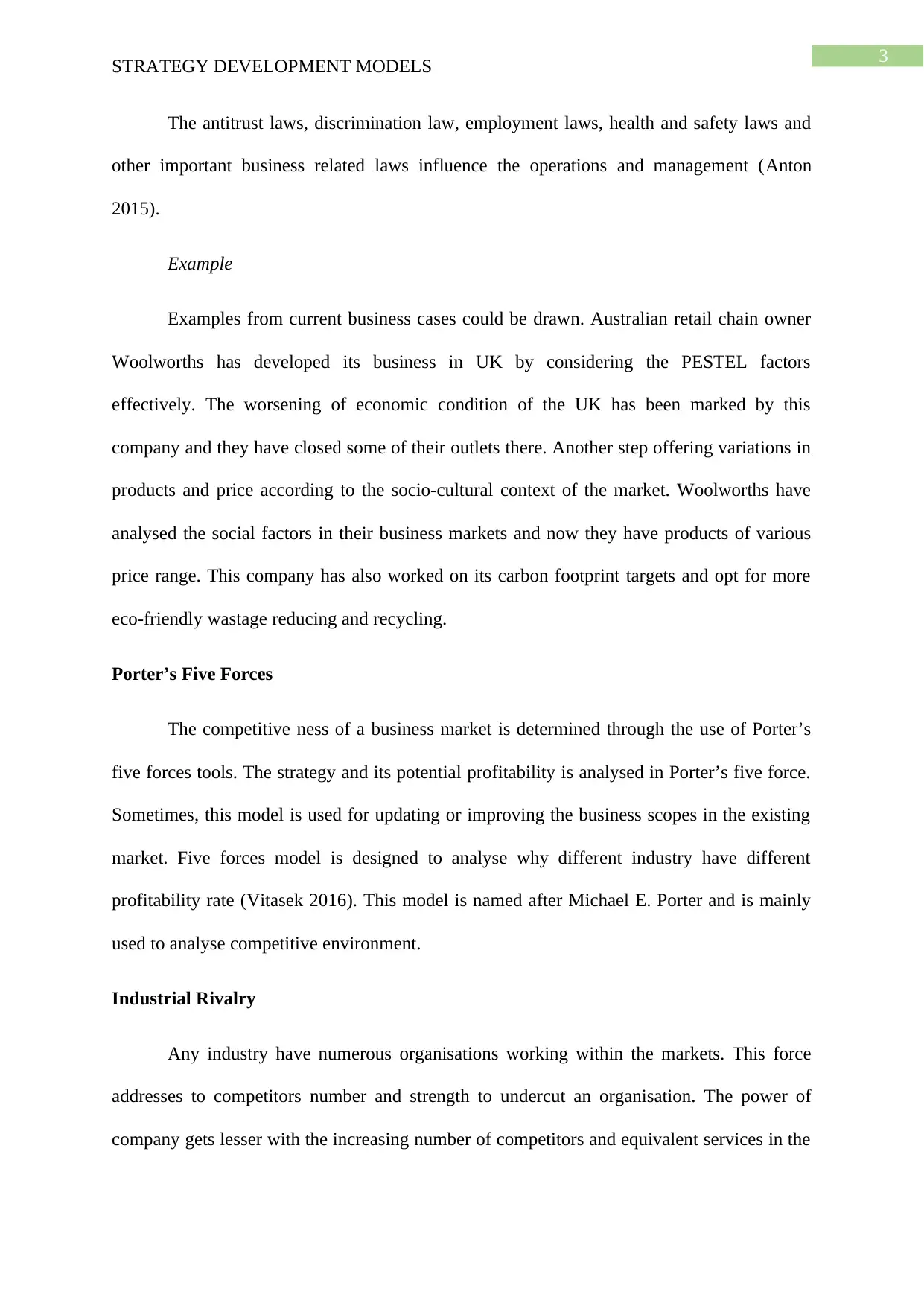
3
STRATEGY DEVELOPMENT MODELS
The antitrust laws, discrimination law, employment laws, health and safety laws and
other important business related laws influence the operations and management (Anton
2015).
Example
Examples from current business cases could be drawn. Australian retail chain owner
Woolworths has developed its business in UK by considering the PESTEL factors
effectively. The worsening of economic condition of the UK has been marked by this
company and they have closed some of their outlets there. Another step offering variations in
products and price according to the socio-cultural context of the market. Woolworths have
analysed the social factors in their business markets and now they have products of various
price range. This company has also worked on its carbon footprint targets and opt for more
eco-friendly wastage reducing and recycling.
Porter’s Five Forces
The competitive ness of a business market is determined through the use of Porter’s
five forces tools. The strategy and its potential profitability is analysed in Porter’s five force.
Sometimes, this model is used for updating or improving the business scopes in the existing
market. Five forces model is designed to analyse why different industry have different
profitability rate (Vitasek 2016). This model is named after Michael E. Porter and is mainly
used to analyse competitive environment.
Industrial Rivalry
Any industry have numerous organisations working within the markets. This force
addresses to competitors number and strength to undercut an organisation. The power of
company gets lesser with the increasing number of competitors and equivalent services in the
STRATEGY DEVELOPMENT MODELS
The antitrust laws, discrimination law, employment laws, health and safety laws and
other important business related laws influence the operations and management (Anton
2015).
Example
Examples from current business cases could be drawn. Australian retail chain owner
Woolworths has developed its business in UK by considering the PESTEL factors
effectively. The worsening of economic condition of the UK has been marked by this
company and they have closed some of their outlets there. Another step offering variations in
products and price according to the socio-cultural context of the market. Woolworths have
analysed the social factors in their business markets and now they have products of various
price range. This company has also worked on its carbon footprint targets and opt for more
eco-friendly wastage reducing and recycling.
Porter’s Five Forces
The competitive ness of a business market is determined through the use of Porter’s
five forces tools. The strategy and its potential profitability is analysed in Porter’s five force.
Sometimes, this model is used for updating or improving the business scopes in the existing
market. Five forces model is designed to analyse why different industry have different
profitability rate (Vitasek 2016). This model is named after Michael E. Porter and is mainly
used to analyse competitive environment.
Industrial Rivalry
Any industry have numerous organisations working within the markets. This force
addresses to competitors number and strength to undercut an organisation. The power of
company gets lesser with the increasing number of competitors and equivalent services in the
Paraphrase This Document
Need a fresh take? Get an instant paraphrase of this document with our AI Paraphraser
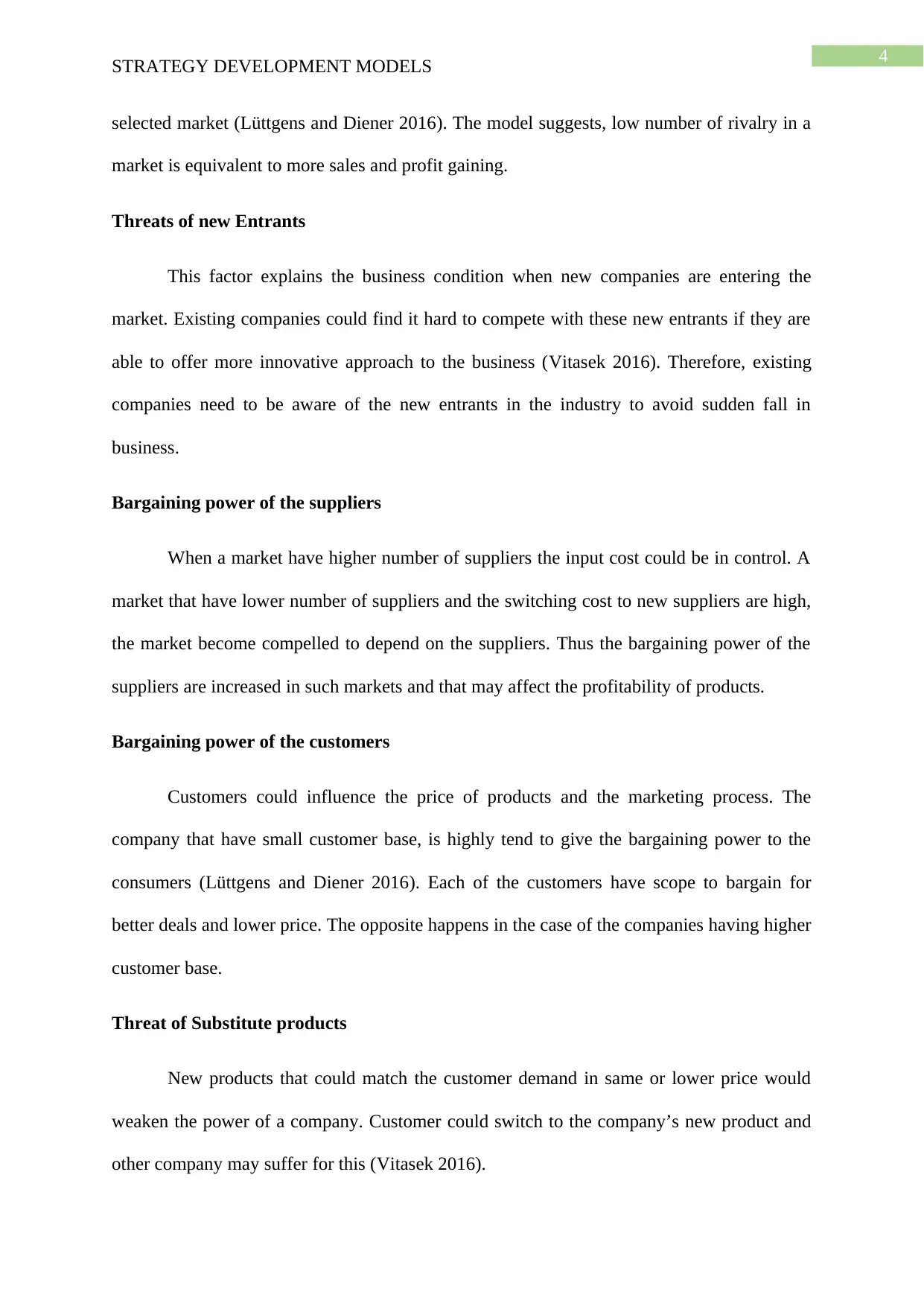
4
STRATEGY DEVELOPMENT MODELS
selected market (Lüttgens and Diener 2016). The model suggests, low number of rivalry in a
market is equivalent to more sales and profit gaining.
Threats of new Entrants
This factor explains the business condition when new companies are entering the
market. Existing companies could find it hard to compete with these new entrants if they are
able to offer more innovative approach to the business (Vitasek 2016). Therefore, existing
companies need to be aware of the new entrants in the industry to avoid sudden fall in
business.
Bargaining power of the suppliers
When a market have higher number of suppliers the input cost could be in control. A
market that have lower number of suppliers and the switching cost to new suppliers are high,
the market become compelled to depend on the suppliers. Thus the bargaining power of the
suppliers are increased in such markets and that may affect the profitability of products.
Bargaining power of the customers
Customers could influence the price of products and the marketing process. The
company that have small customer base, is highly tend to give the bargaining power to the
consumers (Lüttgens and Diener 2016). Each of the customers have scope to bargain for
better deals and lower price. The opposite happens in the case of the companies having higher
customer base.
Threat of Substitute products
New products that could match the customer demand in same or lower price would
weaken the power of a company. Customer could switch to the company’s new product and
other company may suffer for this (Vitasek 2016).
STRATEGY DEVELOPMENT MODELS
selected market (Lüttgens and Diener 2016). The model suggests, low number of rivalry in a
market is equivalent to more sales and profit gaining.
Threats of new Entrants
This factor explains the business condition when new companies are entering the
market. Existing companies could find it hard to compete with these new entrants if they are
able to offer more innovative approach to the business (Vitasek 2016). Therefore, existing
companies need to be aware of the new entrants in the industry to avoid sudden fall in
business.
Bargaining power of the suppliers
When a market have higher number of suppliers the input cost could be in control. A
market that have lower number of suppliers and the switching cost to new suppliers are high,
the market become compelled to depend on the suppliers. Thus the bargaining power of the
suppliers are increased in such markets and that may affect the profitability of products.
Bargaining power of the customers
Customers could influence the price of products and the marketing process. The
company that have small customer base, is highly tend to give the bargaining power to the
consumers (Lüttgens and Diener 2016). Each of the customers have scope to bargain for
better deals and lower price. The opposite happens in the case of the companies having higher
customer base.
Threat of Substitute products
New products that could match the customer demand in same or lower price would
weaken the power of a company. Customer could switch to the company’s new product and
other company may suffer for this (Vitasek 2016).
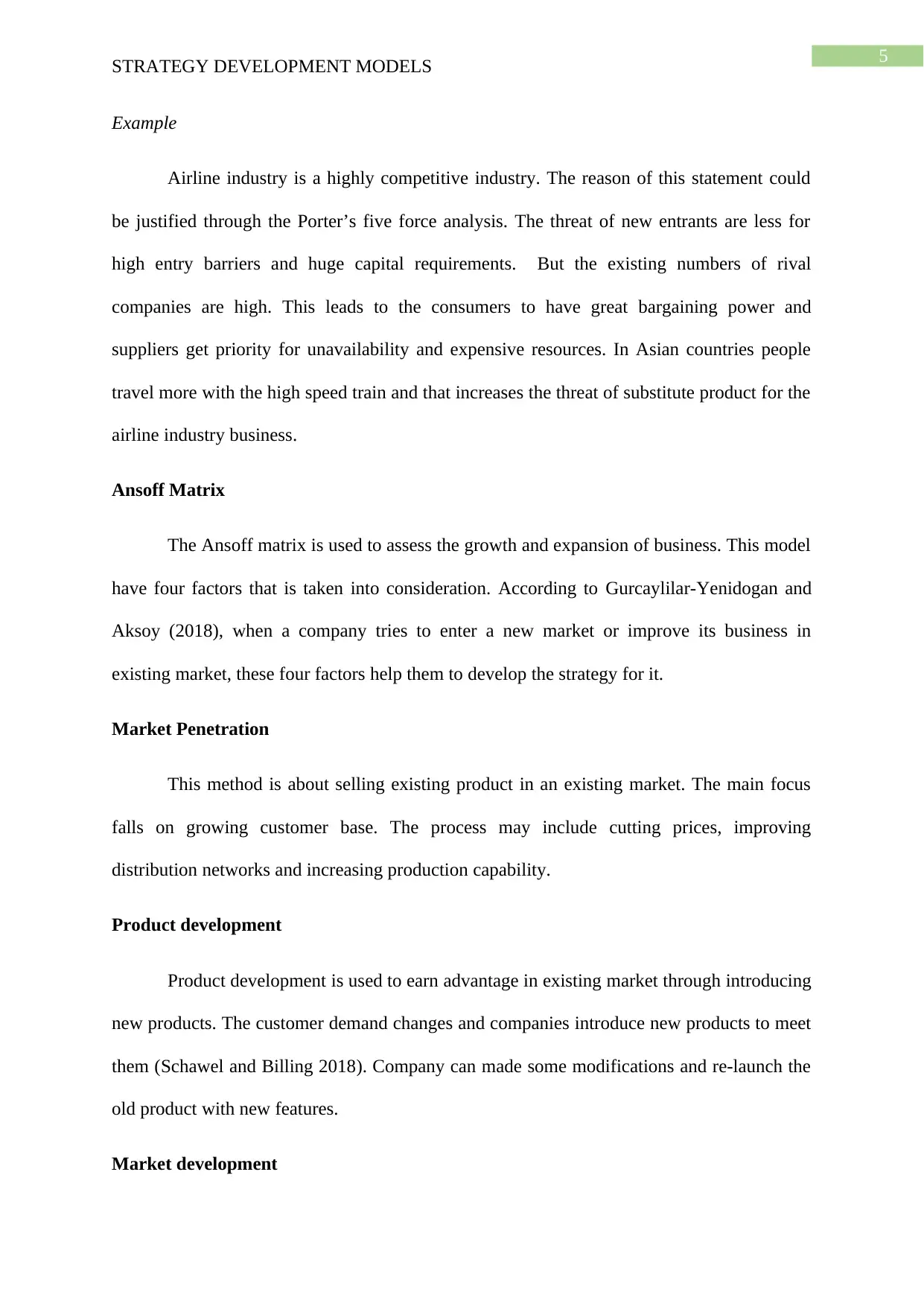
5
STRATEGY DEVELOPMENT MODELS
Example
Airline industry is a highly competitive industry. The reason of this statement could
be justified through the Porter’s five force analysis. The threat of new entrants are less for
high entry barriers and huge capital requirements. But the existing numbers of rival
companies are high. This leads to the consumers to have great bargaining power and
suppliers get priority for unavailability and expensive resources. In Asian countries people
travel more with the high speed train and that increases the threat of substitute product for the
airline industry business.
Ansoff Matrix
The Ansoff matrix is used to assess the growth and expansion of business. This model
have four factors that is taken into consideration. According to Gurcaylilar-Yenidogan and
Aksoy (2018), when a company tries to enter a new market or improve its business in
existing market, these four factors help them to develop the strategy for it.
Market Penetration
This method is about selling existing product in an existing market. The main focus
falls on growing customer base. The process may include cutting prices, improving
distribution networks and increasing production capability.
Product development
Product development is used to earn advantage in existing market through introducing
new products. The customer demand changes and companies introduce new products to meet
them (Schawel and Billing 2018). Company can made some modifications and re-launch the
old product with new features.
Market development
STRATEGY DEVELOPMENT MODELS
Example
Airline industry is a highly competitive industry. The reason of this statement could
be justified through the Porter’s five force analysis. The threat of new entrants are less for
high entry barriers and huge capital requirements. But the existing numbers of rival
companies are high. This leads to the consumers to have great bargaining power and
suppliers get priority for unavailability and expensive resources. In Asian countries people
travel more with the high speed train and that increases the threat of substitute product for the
airline industry business.
Ansoff Matrix
The Ansoff matrix is used to assess the growth and expansion of business. This model
have four factors that is taken into consideration. According to Gurcaylilar-Yenidogan and
Aksoy (2018), when a company tries to enter a new market or improve its business in
existing market, these four factors help them to develop the strategy for it.
Market Penetration
This method is about selling existing product in an existing market. The main focus
falls on growing customer base. The process may include cutting prices, improving
distribution networks and increasing production capability.
Product development
Product development is used to earn advantage in existing market through introducing
new products. The customer demand changes and companies introduce new products to meet
them (Schawel and Billing 2018). Company can made some modifications and re-launch the
old product with new features.
Market development
⊘ This is a preview!⊘
Do you want full access?
Subscribe today to unlock all pages.

Trusted by 1+ million students worldwide
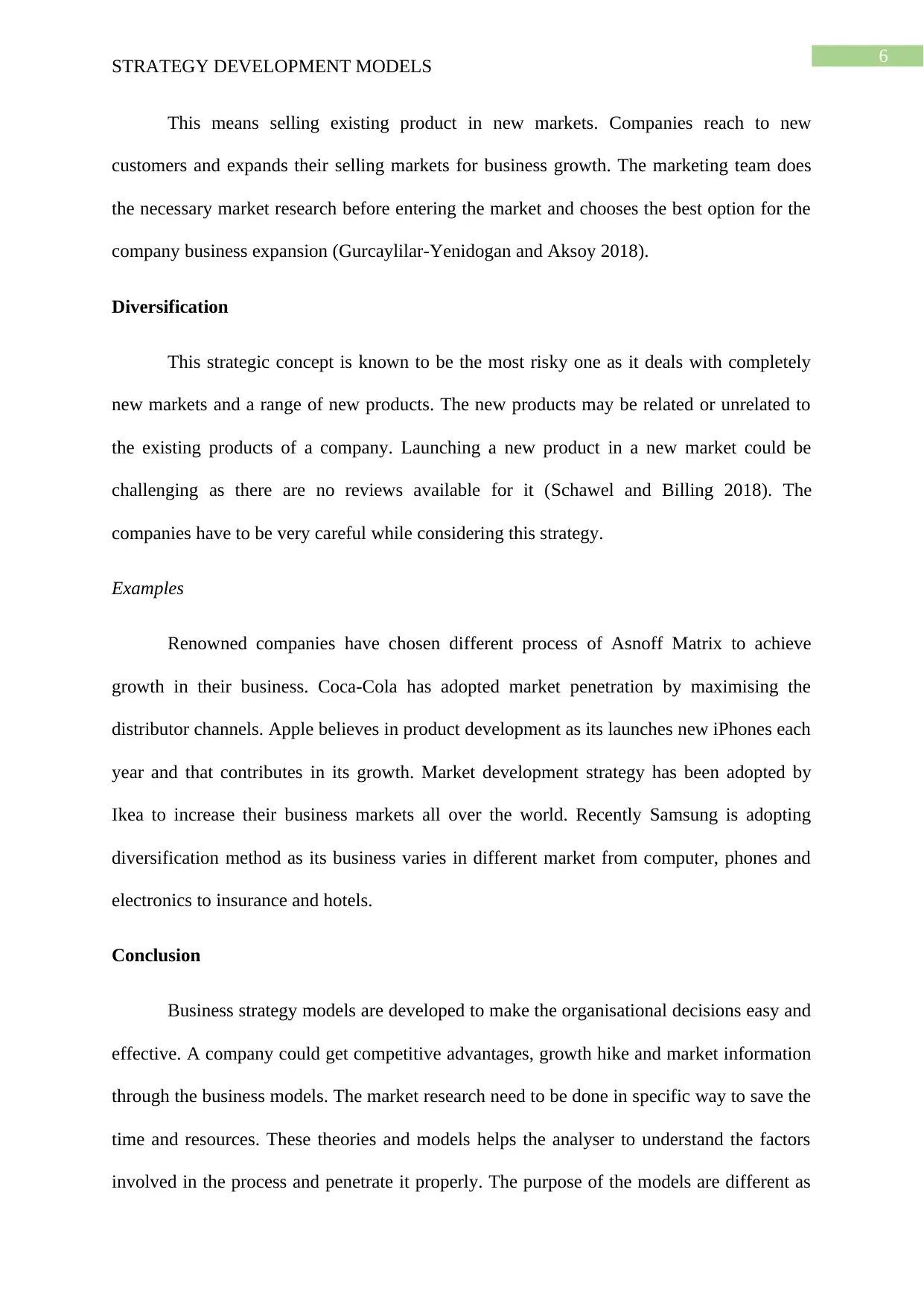
6
STRATEGY DEVELOPMENT MODELS
This means selling existing product in new markets. Companies reach to new
customers and expands their selling markets for business growth. The marketing team does
the necessary market research before entering the market and chooses the best option for the
company business expansion (Gurcaylilar-Yenidogan and Aksoy 2018).
Diversification
This strategic concept is known to be the most risky one as it deals with completely
new markets and a range of new products. The new products may be related or unrelated to
the existing products of a company. Launching a new product in a new market could be
challenging as there are no reviews available for it (Schawel and Billing 2018). The
companies have to be very careful while considering this strategy.
Examples
Renowned companies have chosen different process of Asnoff Matrix to achieve
growth in their business. Coca-Cola has adopted market penetration by maximising the
distributor channels. Apple believes in product development as its launches new iPhones each
year and that contributes in its growth. Market development strategy has been adopted by
Ikea to increase their business markets all over the world. Recently Samsung is adopting
diversification method as its business varies in different market from computer, phones and
electronics to insurance and hotels.
Conclusion
Business strategy models are developed to make the organisational decisions easy and
effective. A company could get competitive advantages, growth hike and market information
through the business models. The market research need to be done in specific way to save the
time and resources. These theories and models helps the analyser to understand the factors
involved in the process and penetrate it properly. The purpose of the models are different as
STRATEGY DEVELOPMENT MODELS
This means selling existing product in new markets. Companies reach to new
customers and expands their selling markets for business growth. The marketing team does
the necessary market research before entering the market and chooses the best option for the
company business expansion (Gurcaylilar-Yenidogan and Aksoy 2018).
Diversification
This strategic concept is known to be the most risky one as it deals with completely
new markets and a range of new products. The new products may be related or unrelated to
the existing products of a company. Launching a new product in a new market could be
challenging as there are no reviews available for it (Schawel and Billing 2018). The
companies have to be very careful while considering this strategy.
Examples
Renowned companies have chosen different process of Asnoff Matrix to achieve
growth in their business. Coca-Cola has adopted market penetration by maximising the
distributor channels. Apple believes in product development as its launches new iPhones each
year and that contributes in its growth. Market development strategy has been adopted by
Ikea to increase their business markets all over the world. Recently Samsung is adopting
diversification method as its business varies in different market from computer, phones and
electronics to insurance and hotels.
Conclusion
Business strategy models are developed to make the organisational decisions easy and
effective. A company could get competitive advantages, growth hike and market information
through the business models. The market research need to be done in specific way to save the
time and resources. These theories and models helps the analyser to understand the factors
involved in the process and penetrate it properly. The purpose of the models are different as
Paraphrase This Document
Need a fresh take? Get an instant paraphrase of this document with our AI Paraphraser
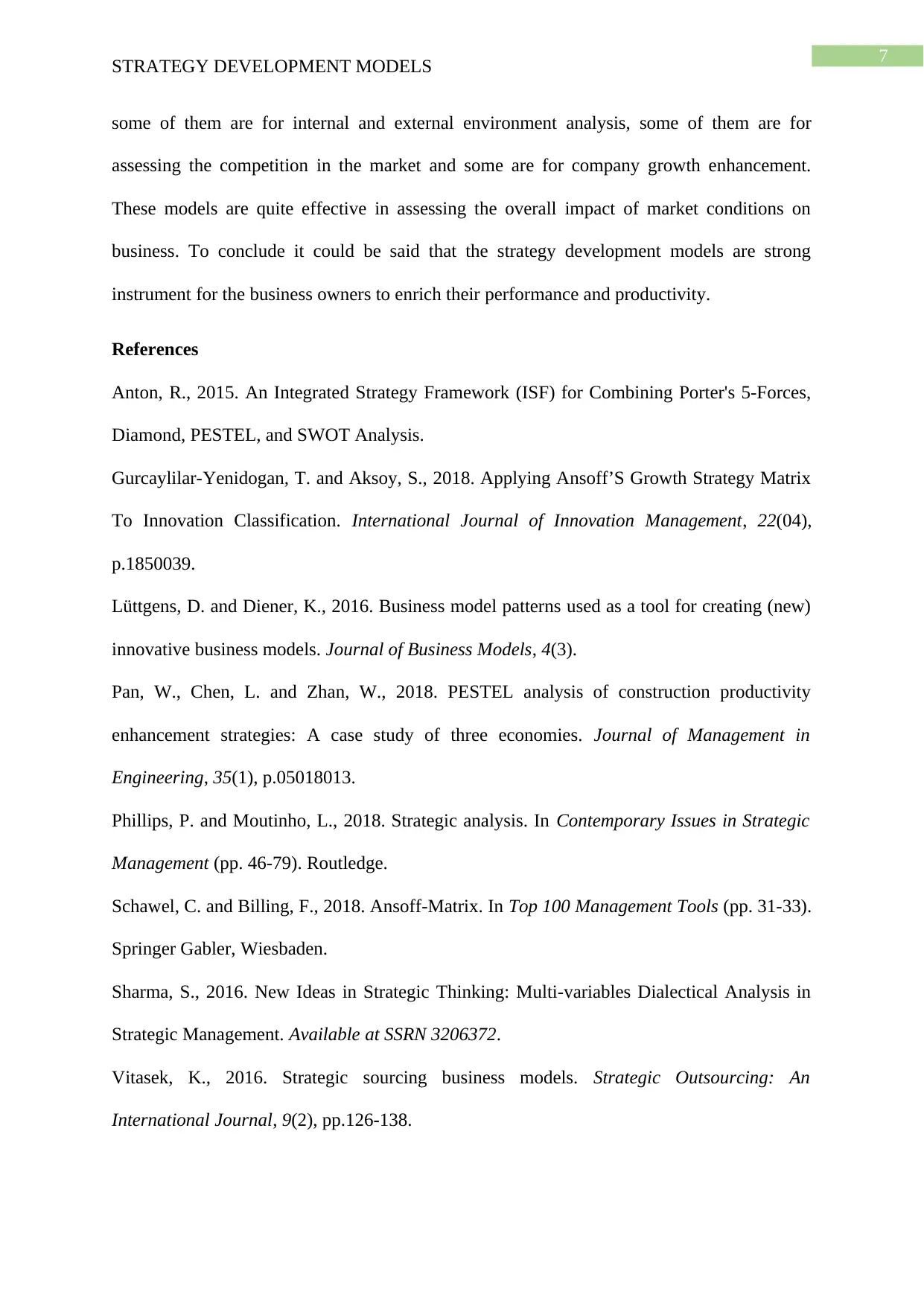
7
STRATEGY DEVELOPMENT MODELS
some of them are for internal and external environment analysis, some of them are for
assessing the competition in the market and some are for company growth enhancement.
These models are quite effective in assessing the overall impact of market conditions on
business. To conclude it could be said that the strategy development models are strong
instrument for the business owners to enrich their performance and productivity.
References
Anton, R., 2015. An Integrated Strategy Framework (ISF) for Combining Porter's 5-Forces,
Diamond, PESTEL, and SWOT Analysis.
Gurcaylilar-Yenidogan, T. and Aksoy, S., 2018. Applying Ansoff’S Growth Strategy Matrix
To Innovation Classification. International Journal of Innovation Management, 22(04),
p.1850039.
Lüttgens, D. and Diener, K., 2016. Business model patterns used as a tool for creating (new)
innovative business models. Journal of Business Models, 4(3).
Pan, W., Chen, L. and Zhan, W., 2018. PESTEL analysis of construction productivity
enhancement strategies: A case study of three economies. Journal of Management in
Engineering, 35(1), p.05018013.
Phillips, P. and Moutinho, L., 2018. Strategic analysis. In Contemporary Issues in Strategic
Management (pp. 46-79). Routledge.
Schawel, C. and Billing, F., 2018. Ansoff-Matrix. In Top 100 Management Tools (pp. 31-33).
Springer Gabler, Wiesbaden.
Sharma, S., 2016. New Ideas in Strategic Thinking: Multi-variables Dialectical Analysis in
Strategic Management. Available at SSRN 3206372.
Vitasek, K., 2016. Strategic sourcing business models. Strategic Outsourcing: An
International Journal, 9(2), pp.126-138.
STRATEGY DEVELOPMENT MODELS
some of them are for internal and external environment analysis, some of them are for
assessing the competition in the market and some are for company growth enhancement.
These models are quite effective in assessing the overall impact of market conditions on
business. To conclude it could be said that the strategy development models are strong
instrument for the business owners to enrich their performance and productivity.
References
Anton, R., 2015. An Integrated Strategy Framework (ISF) for Combining Porter's 5-Forces,
Diamond, PESTEL, and SWOT Analysis.
Gurcaylilar-Yenidogan, T. and Aksoy, S., 2018. Applying Ansoff’S Growth Strategy Matrix
To Innovation Classification. International Journal of Innovation Management, 22(04),
p.1850039.
Lüttgens, D. and Diener, K., 2016. Business model patterns used as a tool for creating (new)
innovative business models. Journal of Business Models, 4(3).
Pan, W., Chen, L. and Zhan, W., 2018. PESTEL analysis of construction productivity
enhancement strategies: A case study of three economies. Journal of Management in
Engineering, 35(1), p.05018013.
Phillips, P. and Moutinho, L., 2018. Strategic analysis. In Contemporary Issues in Strategic
Management (pp. 46-79). Routledge.
Schawel, C. and Billing, F., 2018. Ansoff-Matrix. In Top 100 Management Tools (pp. 31-33).
Springer Gabler, Wiesbaden.
Sharma, S., 2016. New Ideas in Strategic Thinking: Multi-variables Dialectical Analysis in
Strategic Management. Available at SSRN 3206372.
Vitasek, K., 2016. Strategic sourcing business models. Strategic Outsourcing: An
International Journal, 9(2), pp.126-138.
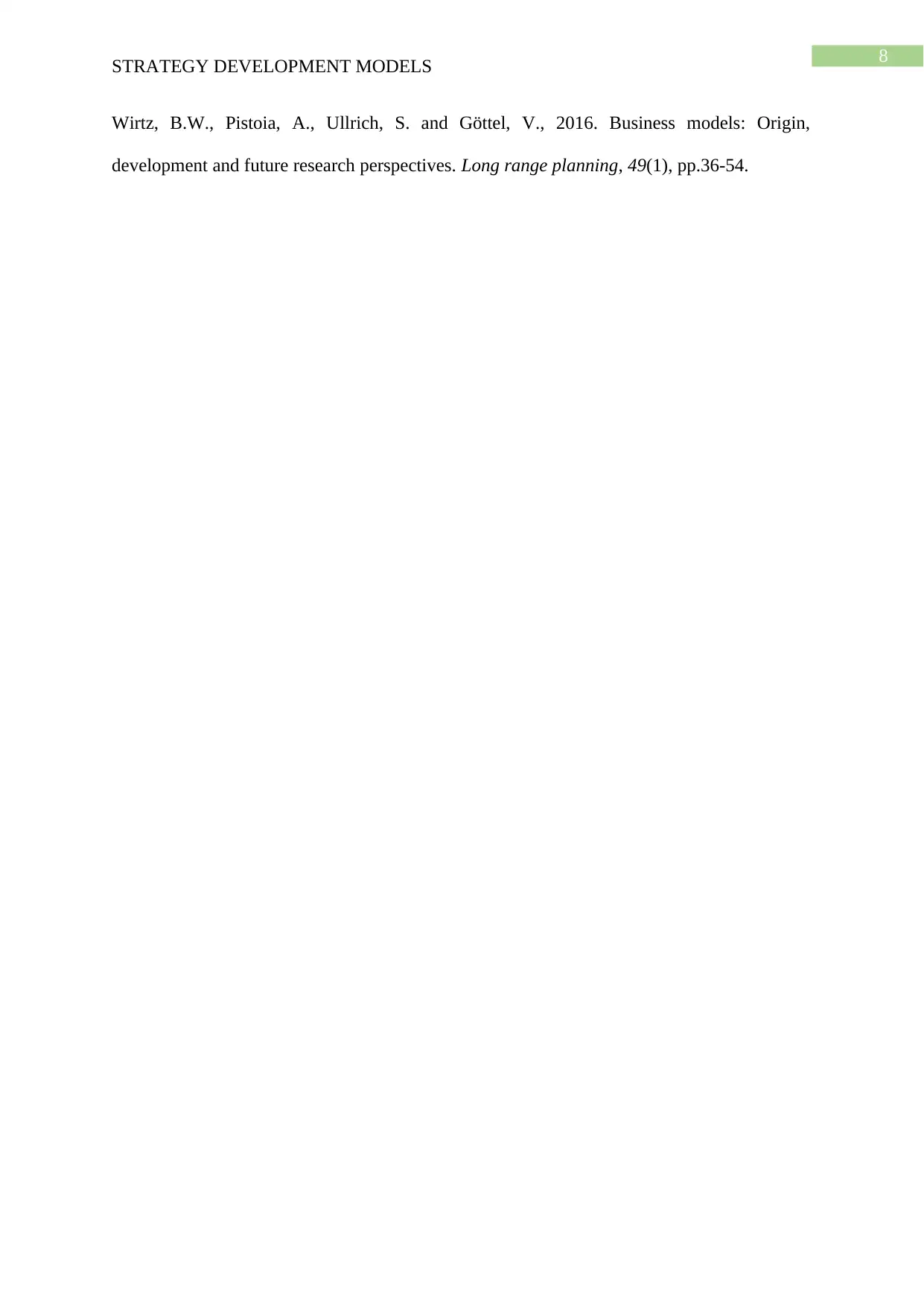
8
STRATEGY DEVELOPMENT MODELS
Wirtz, B.W., Pistoia, A., Ullrich, S. and Göttel, V., 2016. Business models: Origin,
development and future research perspectives. Long range planning, 49(1), pp.36-54.
STRATEGY DEVELOPMENT MODELS
Wirtz, B.W., Pistoia, A., Ullrich, S. and Göttel, V., 2016. Business models: Origin,
development and future research perspectives. Long range planning, 49(1), pp.36-54.
⊘ This is a preview!⊘
Do you want full access?
Subscribe today to unlock all pages.

Trusted by 1+ million students worldwide
1 out of 9
Related Documents
Your All-in-One AI-Powered Toolkit for Academic Success.
+13062052269
info@desklib.com
Available 24*7 on WhatsApp / Email
![[object Object]](/_next/static/media/star-bottom.7253800d.svg)
Unlock your academic potential
Copyright © 2020–2025 A2Z Services. All Rights Reserved. Developed and managed by ZUCOL.





